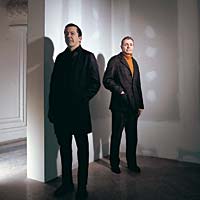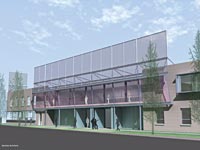|
Photo: Nathan Kirkman |
| Douglas Garofalo (left) and Chuck Thurow in the former Del Prado Hotel; a rendering (below) of the Hyde Park Art Center’s new home |
“I used to wake up at three in the morning out of anxiety. Now I wake up at three in the morning out of excitement,” says Chuck Thurow, the executive director of the Hyde Park Art Center since 1998. The source of his anticipation is the community organization’s move this spring to a freestanding building at 5020 South Cornell Avenue, its tenth relocation since it was founded in 1939 to stage exhibitions by local artists and to provide art classes for children and adults.
As the center changed addresses over the years, its archives were carted along in shopping bags. Finally, in 1976, its members decided to peruse them for a history. Accounts of the exhibitions during those years document a time of zany brilliance and surreal wit. Artists such as Ed Paschke, Gladys Nilsson, and Jim Nutt-then rising stars-appeared in shows with titles such as the Hairy Who, the Nonplussed Some, and the Nonplussed Some Some More.
At a retreat four years ago, the center’s board members decided they were nonplussed yet again. “They needed to rebuild their donor base and address the visibility of the organization,” Thurow recalls. Key to that was a new home. For more than 20 years, the center had been sit-uated in the former Del Prado Hotel, now a rental building, where the baroque ballroom served as the exhibition space.
Before he took over at the center, Thurow was a deputy commissioner of urban planning for the city. A major move was right up his line, and he found the solution at the University of Chicago. Built in the 1930s or 1940s, the two-story 35,000-square-foot brick structure on Cornell had housed the university’s printing and office service departments. The U. of C. agreed to donate the space rent free for 35 years if the center would raise the money for a renovation and fund programs to fill the site.
By December 2005, the center had raised $5.7 million, and a renovation by Douglas Garofalo, the principal of Garofalo Architects, was under way. “He was taking old buildings and making radical transformations, and we were trying to make a real signature statement,” says Thurow. The design comprises multiple exhibition and studio spaces, reference and community centers, and a café. A digital system will project images on the façade, where overhead doors open to a front courtyard. “It was a way to make the institution more con nected to the outside world,” Garofalo says, “more visible, even permeable.” For Takeover, the inaugural exhibition scheduled to open on April 22nd, artists have been invited to respond to the new interior. The first work to appear on the façade is a collaboration by the conceptual artist Iñigo Manglano-Ovalle and Mark Hereld, a computer scientist at Argonne National Laboratory. “It’s a computer-driven real-time video production,” Manglano-Ovalle explains. “The subject is a digitally created undulating cloudscape that is affected by the weather conditions at the art center.” Proof that 67 years after its founding, the Hyde Park Art Center again is about to be ahead of its time.




